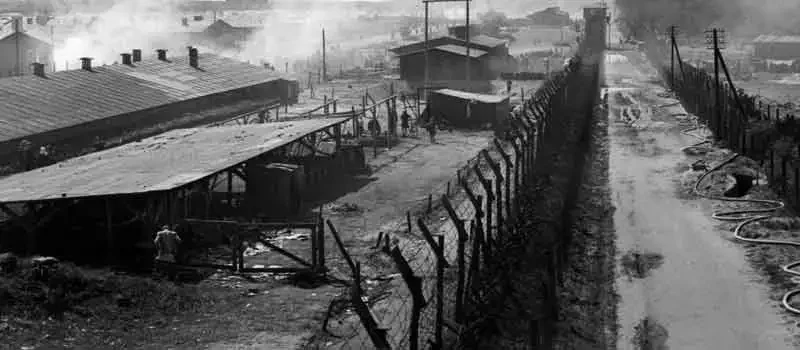- Military History
- Prisons, Prisoners & Camps
- Nazi Camps
- Bergen-Belsen Concentration Camp (1943-1945)

Bergen-Belsen Concentration Camp (1943-1945) A concentration camp complex located near Hanover, Germany
In April 1945, British forces liberated Bergen-Belsen, a concentration camp complex near Hanover, Germany. The contents of the "Horror Camp" shocked and disgusted hardened soldiers and medics alike. Because of extensive British film and press coverage of conditions in the camp, it was held up as a symbol of the cruelty of the Nazi regime and provided further evidence to the Allies of the Nazis' program to exterminate European Jewry.
Unlike the Auschwitz-Birkenau concentration camp, Bergen-Belsen's installations did not include gas chambers or large crematoria. Bergen-Belsen was originally built to house prisoners of war near German Army barracks constructed in 1935, but by 1942 the camp was nearly empty after epidemics decimated the primarily Russian prison population. In April 1943, slave laborers were used to rebuild the Bergen-Belsen site as the result of an agreement between the German Foreign Office and the SS-Schutzstaffel, who planned to detain 30,000 Jews for an exchange program.
The Austauschjuden, or "Exchange Jews," were prominent Jews or those holding dual nationalities, held ransom for German prisoners held by Allied governments. Approximately 7,000 exchange Jews from Poland, Greece, Spain, Holland, and Hungary were sent to Bergen-Belsen from July 1943 to early 1944, although many of the Poles were sent to Auschwitz-Birkenau the following year. Prisoners were housed in subdivisions of the camp complex by nationality or political status.
As in other camps, work was mandatory. Prisoners labored for long hours, salvaging leather from shoes, working in the kitchen, and extracting valuables from corpses. The SS guards often withheld food from prisoners or administered brutal beatings as punishment for failure to meet their quota. During the first year of their internment, Hungarian exchange Jews received moderately merciful treatment, since they did not have to work or attend roll calls and could wear civilian clothing.
In the first half of 1944, food was inadequate but endurable; prisoners were given a daily ration of thin soup, bread, and turnips. There was inadequate sanitation, no privacy, and no medication available for prisoners despite an improvised hospital section in the camp. Despite the hardships, a limited cultural life was pursued by healthy inmates, and some groups maintained Jewish law to provide a measure of structure and government in the camp. Most maintained the hope of escaping from the camp through the exchange program. Ultimately, very few Jews were successfully rescued from the camp by diplomatic means.
In March 1944, because of a decision by the SS that the complex was underutilized, Bergen-Belsen was designated a reception camp for sick prisoners, and a section of the camp was set aside for this purpose. In the deceptively named “Erholungslager” (Recuperation Camp), people living with tuberculosis were housed in bare huts with no blankets, mattresses, or medical attention. Many of these prisoners died shortly thereafter.
The population of the camp exploded as German forces retreated from Poland and the SS evacuated forced laborers and political prisoners from the eastern extermination camps by train or in death marches. In December 1944, Bergen-Belsen was transformed into a concentration camp under the brutal command of SS Captain Josef Kramer, a former commander at Auschwitz-Birkenau. Prisoners were forced to attend a roll call in freezing temperatures, resulting in many deaths.
Captives arrived by the tens of thousands; overcrowding, undernourishment, and exposure fed a typhus epidemic. Huts meant to house 60 people were crammed with 600 prisoners. The crematorium was inadequate to the task, and corpses littered the ground in piles outside the squalid, overcrowded huts and tents, causing further disease. It is estimated that over 35,000 prisoners died of starvation and disease between January and April 1945.
On 12 April 1945, German forces in the area surrendered to the advancing British 2nd Army. The Germans deceptively portrayed Bergen-Belsen as a quarantined prisoner of war camp afflicted by typhus; as a result, it was not liberated until 15 April 1945. British soldiers of the 63rd Anti-Tank Regiment discovered over 10,000 unburied corpses and 50,000 emaciated survivors in various stages of starvation, guarded by German and Hungarian SS troops. The prisoners were fed barely 400 calories daily in the last weeks before liberation, but had gone without nourishment since the German surrender. There was evidence of cannibalism.
British soldiers were skeptical when they found tons of untouched Red Cross food and medical supplies at a nearby German Army training school. Inmates remained in camp to receive treatment and nourishment, but 14,000 more died before doctors could gain control over outbreaks of typhus and dysentery. In a ceremony on 21 May 1945, the last vestiges of Bergen-Belsen were burned to the ground by the British.
Though reports had been received from the Red Army of the horrors at extermination camps, Bergen-Belsen was the first concentration camp to be extensively photographed and filmed by the British. Over radio broadcasts, in print, and in movie theaters, the horrific story of conditions within Bergen-Belsen was widely circulated to show the inhumanity of the Nazi regime and provided further moral justification to the Allies' war effort.
Map
- {{#owner}}
- {{#url}} {{#avatarSrc}}
{{name}} {{/url}} {{^url}} {{#avatar}} {{& avatar}} {{/avatar}} {{name}} {{/url}} - {{/owner}} {{#created}}
- {{created}} {{/created}}























